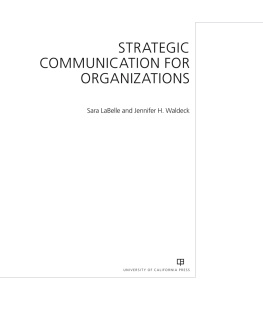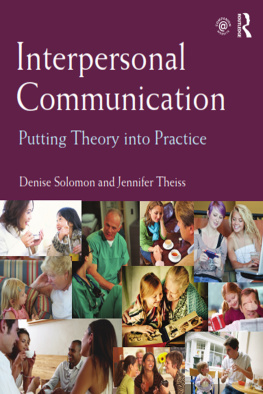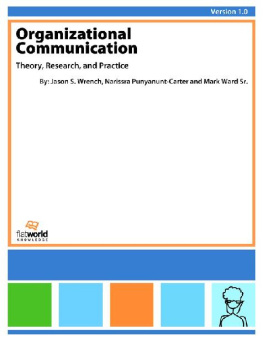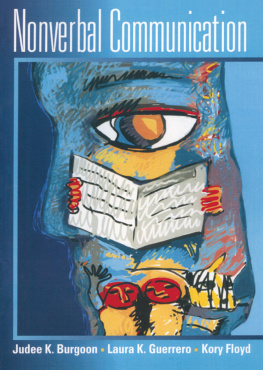Using Communication Theory
Using Communication Theory
Second edition
An Introduction to Planned Communication
Sven Windahl and Benno H. Signitzer With Jean T. Olsen

Sven Windahl and Benno H. Signitzer with Jean T. Olson 2009
This edition first published 2009 First published 1992
Apart from any fair dealing for the purposes of research or private study, or criticism or review, as permitted under the Copyright, Designs and Patents Act, 1988, this publication may be reproduced, stored or transmitted in any form, or by any means, only with the prior permission in writing of the publishers, or in the case of reprographic reproduction, in accordance with the terms of licences issued by the Copyright Licensing Agency. Enquiries concerning reproduction outside those terms should be sent to the publishers.
SAGE Publications Ltd
1 Olivers Yard
55 City Road
London EC1Y 1SP
SAGE Publications Inc.
2455 Teller Road
Thousand Oaks, California 91320
SAGE Publications India Pvt Ltd
B 1/I 1 Mohan Cooperative Industrial Area
Mathura Road, New Delhi 110 044
SAGE Publications Asia-Pacific Pte Ltd
33 Pekin Street #02-01
Far East Square
Singapore 048763
Library of Congress Control Number: 2008920956
British Library Cataloguing in Publication data
A catalogue record for this book is available from the British Library
ISBN 978-1-4129-4838-8
ISBN 978-1-4129-4839-9
Typeset by C&M Digitals (P) Ltd., Chennai, India
Printed in Great Britain by TJ International, Padstow, Cornwall
Printed on paper from sustainable resources
Contents
Preface to first edition
The aim of this book is to provide an overview of theories for communication planning. We pursue two goals. First, we aim to familiarize practitioners working in the field of communication planning with the many theories that both communication scientists and practitioners have developed over the last two decades or so, and which, so we shall argue, can be quite helpful to planners in the design, implementation, and evaluation of their projects. Second, we offer the student of communications a first exposure to the often bewildering world of communication theory. The particular approach of the book should facilitate access and overcome some of the psychological obstacles.
What, then, is our approach? We will attempt to relate communication theories to situations of communication planning work. Thus, the practitioner is informed about theories in a way that is designed to be close to his or her everyday work situation and experience. The student of communication, correspondingly, will find that theory is something that can and does have a very practical use.
The book can be used both as a textbook for the (mass) communication student and as a thought-provoking book that can inform the practitioners work. It covers a wide range of theories, (nearly) all of which are illustrated by practical examples from communication planning thus bringing home the point that the study of theories is not lart pour lart, an end in itself, but can serve very useful purposes. This, we believe, makes it unique as a communication theory textbook. And we know both from our own personal teaching experiences and from other communication teachers that there is a need for such a text.
We wish to extend our thanks to Stephen Barr and Nicola Harris of Sage for being such kind and competent editors; to the anonymous reviewers whose critical evaluations were particularly helpful; to Professor Everett M. Rogers for his comments on an early draft and his very specific advice; to our students in Sweden, Austria, Germany, and the United States who were exposed to the content of the book as it evolved and provided us with invaluable critical insights, and, above all, with the very rationale and motivation to bring the work to completion. We are also grateful for the economic support given to us by the Vxj University, Sweden, which made several trips between our three countries possible.
S.W.
B.S.
J.T.O.
Note on the New Edition
We wrote this book because we saw a need for a text that could provide practitioners in the field of communication planning with an overview of theories that can be used in all phases of communication projects. At the same time we had in mind all those students in communication who may find theories more accessible and understandable when systematically related to practice.
These aims still hold true today. Reactions from practitioners, students and teachers have furthermore supported the idea that communication planning practice is, more than ever, in need of a good theoretical underpinning. Why is that? Here are three possible answers:
- The success of any communication effort is faced with an increasing amount of threats, the sheer number of competing messages being the most important. Theory guides us in our efforts to win the attention and to obtain effects in situations of often deafening noise.
- Communication is one of those fields of human activity where everyone may consider him/herself an expert. Communication practitioners need to be able to argue convincingly for their solutions in discussions with their counterparts within and outside the organization.
- It is encouraging to see communicators being in the process of becoming a profession. Professions and professions-to-be need to act based on a more or less coherent theory of the field in order to gain trust, reputation, and autonomy. Our book provides this kind of useful and tested theory.
What is, then, new in this edition?
While essentially based on the first edition, this new edition includes a number of changes designed to (a) update the text and (b) enhance the books use as a textbook. The changes include the addition of a number of features, notably:
- Learning aims for each chapter;
- Prompts to reflection;
- Extension material;
- Exercises;
- Lists of key terms.
The learning aims are designed to highlight key points in each chapter so that readers know what to expect. The intention is to assist readers in navigating the text and organizing thoughts as they read. It will also prove useful at the end of the chapter to go back to the learning aims and check that they have been attained.
The prompts to reflection are designed to encourage readers to relate the contents of the book to their own experience and, in some places, to explore connections between chapters.
In addition, new references have also been added in order to guide the interested reader in finding further information on a given topic.
As authors we want to express our gratitude to Sage. In issuing this new version of the book, the publisher shows that it shares our view that both students and practitioners need theory that strengthens the practice of planned communication.
S.W.
B.S.
J.T.O
Introduction
Contents
Communication planning is a broad and multi-faceted concept; it is used every day by thousands and thousands of people by public relations practitioners, technical writers, information campaigners, advertising professionals, organization consultants, educators, health communicators, and many, many others. The term communication planning is probably less common than the activity it describes. That may have to do with a hesitancy to connect the notion of communication, which is thought of as being spontaneous in nature, with the idea of planning, which is usually associated with such concepts as management, control, and strategy. In this book we shall argue that in order to achieve good results (for good causes), the two communication and planning must go hand in hand.
Next page









